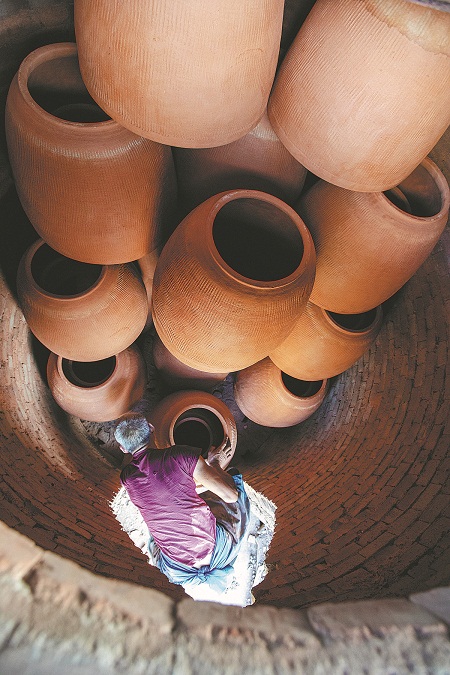porcelain sheds light on nation's history and culture
an artisan in jinhua, zhejiang, prepares to place pottery in a kiln. [photo by yang meiqing/for china daily]
treasured item
the zhejiang provincial museum is home to one of its most-treasured items-a piece of longquan celadon made during the southern song period.
the piece, which is 16.7 centimeters long, 6.5 cm wide and 9.3 cm high, is a boat-shaped water dropper, a device commonly used in ancient china to put water on inkstones when grinding ink sticks.
carved columns are on the left and right sides of the item, with a pavilion cabin in the center. a rolled-down shelter is at the back, with the anchor and oars also shown in vivid detail. two passengers are positioned inside the cabin, as the boatman-standing outside and appearing to be preparing to moor the vessel-leans over to collect his bamboo hat from the roof. his robe flows in the wind.
cai naiwu, a ceramics expert at the museum, said, "this piece represents the height of longquan porcelain-making, and shows just how exquisite and unique it is. the unearthed water droppers from the southern song dynasty, or even later, are all different."
when the item was discovered in 1956, it was neither the result of archaeological excavations of major burial sites, nor found to be from any known imperial collections. local farmers simply located the relic in a field and handed it to the authorities.
cai said, "the song dynasty vigorously encouraged the development of culture, which reached unprecedented levels." cai added that the boat-shaped water dropper is likely to have been custom-made for a member of the literati-a common practice at the time.
in september 2009, unesco inscribed the traditional firing technology for longquan celadon on its representative list of the intangible cultural heritage of humanity.
while it may not be among the four great inventions of ancient china-papermaking, printing, gunpowder and the compass-porcelain is an indisputably ingenious creation by the ancient chinese that combines art and technology, and integrates aesthetics with practicality.
more important, it provides clues to china's past, cai said, adding, "thanks to its durability, porcelain can be likened to a chip that stores countless and invaluable information about china's history, society and culture."
for example, celadon was favored by the imperial chinese court for a long time until the yuan dynasty (1271-1368), when blue-and-white porcelain came into vogue and its production base gradually shifted to jingdezhen, jiangxi, and elsewhere.
cai said the yuan rulers' tastes undoubtedly played an important role, but the changes they made were, to some extent, a conscious display of power, as they sought to exert themselves and eradicate the influences of the southern song dynasty, their predecessor.
-
'nice' to meet you, hangzhou
may 6, 2024


